6 June 2017
Loading sags in homogeneous lithologies?
Posted by Callan Bentley
I was out in the field over the weekend, and saw something new. Readers, I’d be eager to hear what you think of it.
The feature is what appears to be a series of small “ball and pillow” type loading structures (soft sediment deformation), but the thing that’s weird about them is rather than being sand sagging into mud, we have instead silt or fine sand sagging into identical sediment. Check it out; in each case I offer a plain photo followed by a version with the base of the “pillows” highlighted:
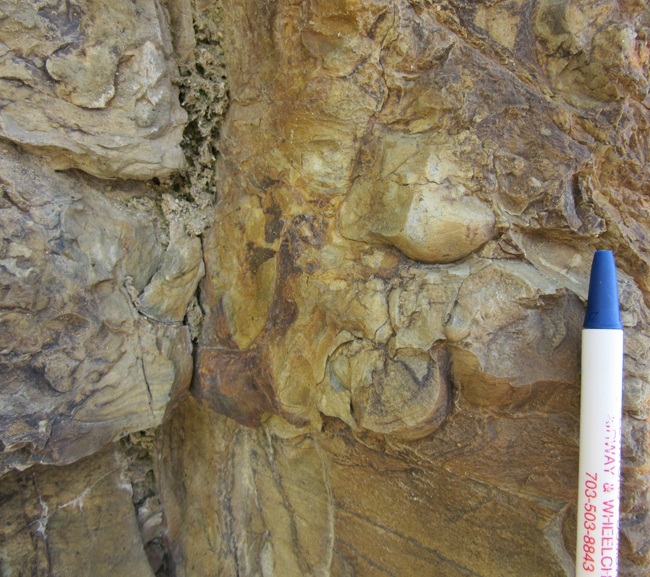
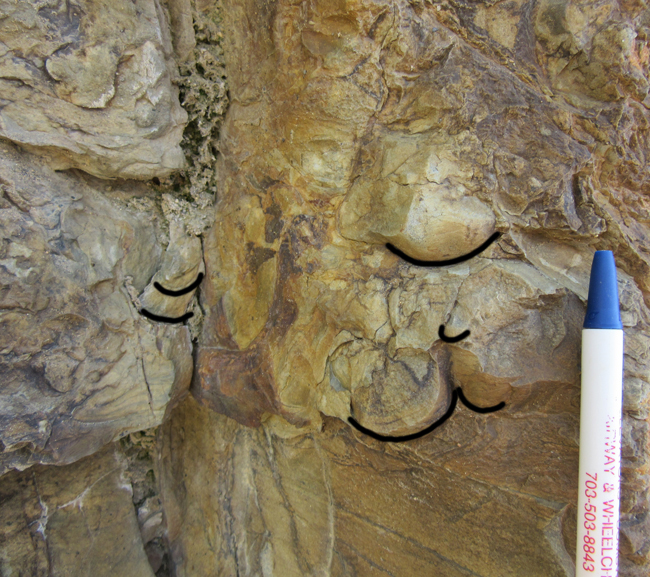
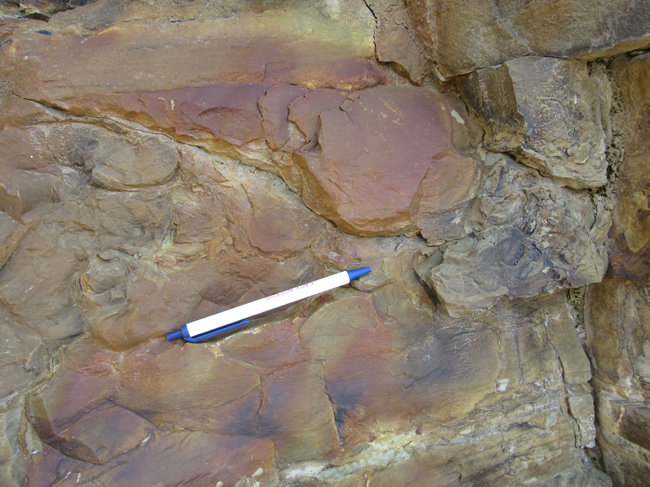
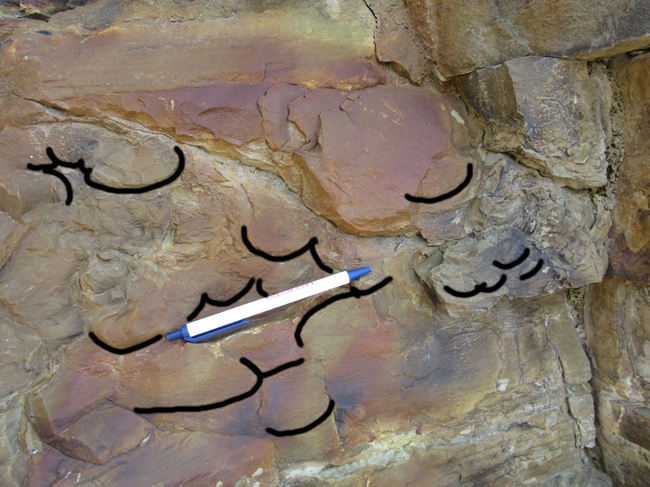

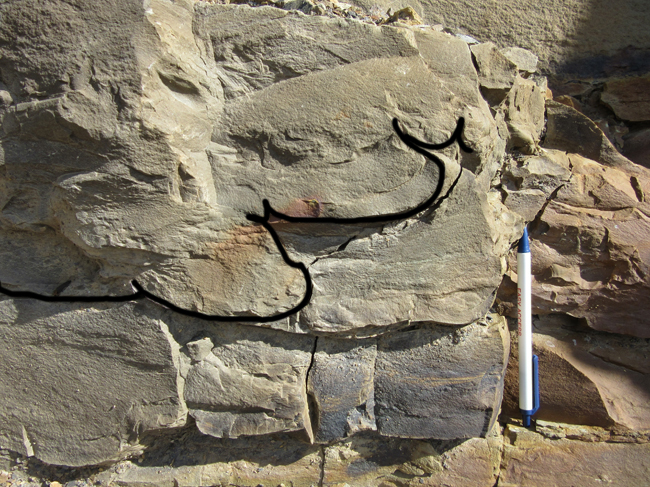
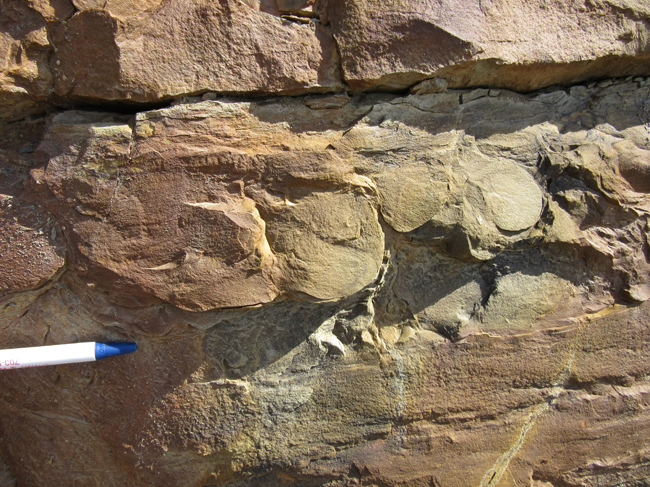
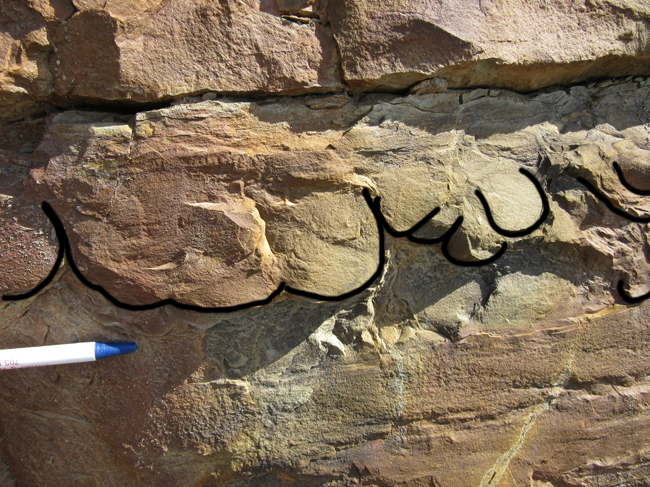
Some of these have very compelling shapes. It just seems so bizarre that they could exist in sediments where the lower layer appears to have the same grain size (and thus mechanical properties?) as the upper layer. Where’s the differential viscosity coming from? Perhaps there was a component of seismicity that induced these structures to form through preferential liquefaction of the lower layer? Does that even make sense? Could it be that there used to be a lot more mud here, but it all got squished out of the outcrop through volume loss, and so doesn’t appear in modern cross-sections? The last one I think is most compelling as a traditional case of density inversion, with a slight difference in grain size preserved through the differential weathering profile: beds crisp at the base, then grading slightly upward to the crisp base of the overlying bed. It may be that examination under a microscope would reveal a discernible grain size difference.
It may be relevant that this site is very close (just a few meters above) the mass transport deposit I showcased previously.
Thoughts? (Thanks in advance)


 Callan Bentley is Associate Professor of Geology at Piedmont Virginia Community College in Charlottesville, Virginia. He is a Fellow of the Geological Society of America. For his work on this blog, the National Association of Geoscience Teachers recognized him with the James Shea Award. He has also won the Outstanding Faculty Award from the State Council on Higher Education in Virginia, and the Biggs Award for Excellence in Geoscience Teaching from the Geoscience Education Division of the Geological Society of America. In previous years, Callan served as a contributing editor at EARTH magazine, President of the Geological Society of Washington and President the Geo2YC division of NAGT.
Callan Bentley is Associate Professor of Geology at Piedmont Virginia Community College in Charlottesville, Virginia. He is a Fellow of the Geological Society of America. For his work on this blog, the National Association of Geoscience Teachers recognized him with the James Shea Award. He has also won the Outstanding Faculty Award from the State Council on Higher Education in Virginia, and the Biggs Award for Excellence in Geoscience Teaching from the Geoscience Education Division of the Geological Society of America. In previous years, Callan served as a contributing editor at EARTH magazine, President of the Geological Society of Washington and President the Geo2YC division of NAGT.
I wonder if, rather than load structures, they are a type of small scale scour-and-fill feature caused by turbulent (and very turbid—perhaps a slurry) flow onto a slightly consolidated bed of the same sediment. For evidence, I would expect the “pillows”/“load casts” to have little or no internal structure (due to chaotic, turbulent turbidity flow), versus the underlying/scoured bed which might be more conventionally laminated, rippled, cross-bedded, etc. I fancy that I can see such a situation in all the photos, where the “pillows” overlie horizontally bedded sandstone. The second and fourth photos, in particular, seem to show a “pillowed” bed over- and underlain by horizontally laminated beds.
Another possibilty that occurs to me—though in my mind much less likely, is that they are some kind of bioturbation by a large organism (big-ass trilobite?) burrowing through particular beds. Unfortunately, the main evidence for this, I think, would also be structureless sediment overlying structured sediment.
Time for oriented thin sections across what you have identified as the sag boundaries to see if grains have an orientation in some manner or possibly rotated. I would wonder also if what you are seeing in macro is possibly a representation of some diagenic feature. When I first saw your annotated picture, the idea that they represent some sort of ‘mini-roll’ structure (akin to the larger roll structures that concentrate uranium). Either way (of any hypotheses) the thin sections would be a good first investigation to make.
I am with Howard as far as they look like sediment loading structures to my eye, not bioturbation. They appear to be flame structures, with fluidized fines protruding into the overlying sand bed.
Thanks!